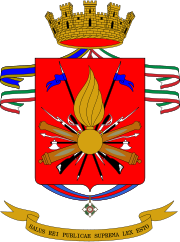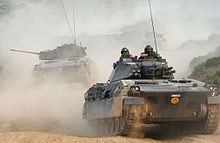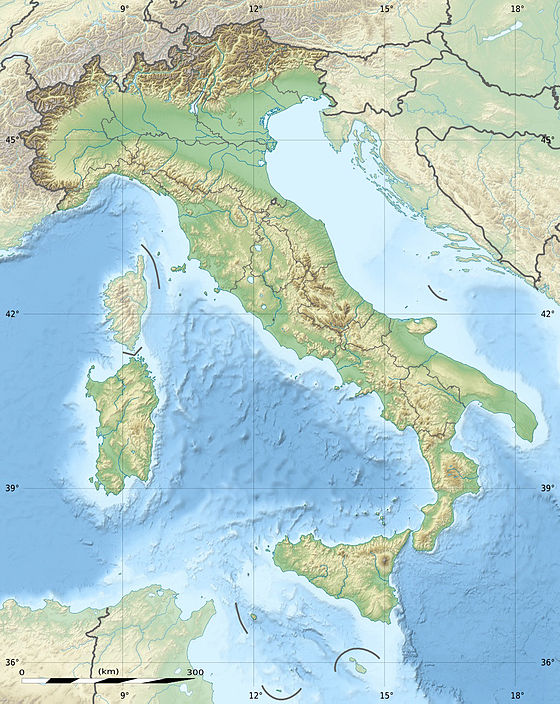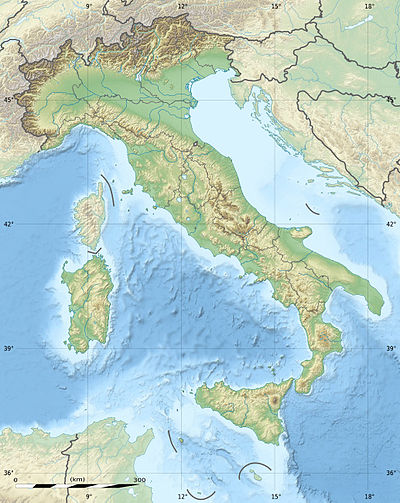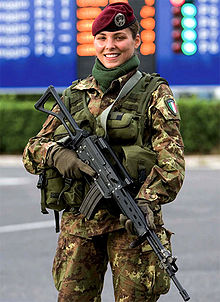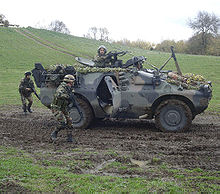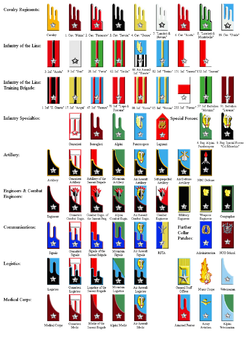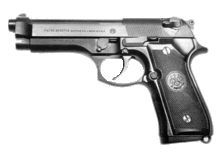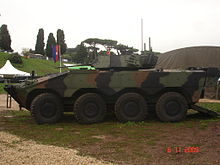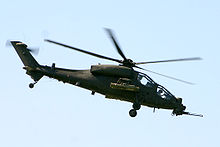- Italian Army
-
Esercito Italiano
Italian Army
Coat of Arms of the Italian ArmyActive 27 March 1861 - today Country Italy Allegiance Italian Republic Type Army Size 108,000 Part of Italian Supreme Defense Council Garrison/HQ Rome Motto Latin: Salus Rei Publicae Suprema Lex Esto
"The safeguard of the republic shall be the supreme law"Engagements Risorgimento
War of 1866
First Italo-Abyssinian War
Italo-Turkish War
World War I
Second Italo-Abyssinian War
Spanish Civil War
Italian invasion of Albania
World War II
Iraq War
War in Afghanistan
War on TerrorismCommanders President of the Italian Republic Giorgio Napolitano Stato Maggiore dell’Esercito
(Chief of the Army General Staff)Generale Giuseppe Valotto Notable
commandersGiuseppe Garibaldi
Armando Diaz
Luigi Cadorna
Emanuele Filiberto, 2nd Duke of Aosta
Enrico Caviglia
Ettore Bastico
Emilio De Bono
Ugo Cavallero
Pietro Badoglio
Rodolfo Graziani
Giovanni MesseInsignia Logo 
The Italian Army (Esercito Italiano) is the ground defence force of the Italian Armed Forces. It is all-volunteer force of active-duty personnel, numbering 108,355 in 2010.[1] Its best-known combat vehicles are the Dardo infantry fighting vehicle, the Centauro tank destroyer and the Ariete tank, and among its aircraft the Mangusta attack helicopter, recently deployed in UN missions. The headquarters of the Army General Staff are located in Rome, opposite the Presidential Palace.
The army's history dates back to the unification of Italy in the 1850s and 1860s. The army fought in colonial engagements in China, Libya (1911), northern Italy against the Austro-Hungarian Empire during World War I, Abyssina before World War II, and in World War II in Albania, Greece, north Africa, and Italy itself. During the Cold War the army prepared itself to defend against a Warsaw Pact invasion from the east. Since the end of the Cold War the army has seen extensive peacekeeping service and combat in Afghanistan.
Contents
History
The Italian Army originated as the Royal Army (Regio Esercito) which dates from the proclamation of the Kingdom of Italy following the seizure of the Papal States and the unification of Italy (Risorgimento). In 1861, under the leadership of Giuseppe Garibaldi, Victor Emmanuel II of the House of Savoy was invited to take the throne of the newly independent kingdom.
Italian expeditions were despatched to China during the Boxer Rebellion of 1900 and to Libya during the Italo-Turkish War of 1911.
World War I
The Italian Royal Army's first real taste of modern warfare was during World War I. Most of the actions were fought in northern Italy and the Royal Army suffered many casualties. This included over 700,000 dead. The frequency of offensives for which the Italian soldiers partook between May 1915 and August 1917, one every three months, was higher than demanded by the armies on the Western Front. Italian discipline was also harsher, with punishments for infractions of duty of a severity not known in the German, French, and British armies.[2]
During the Interwar Years the Royal Army participated in the Italian Invasion of Ethiopia, provided men and materials during the Spanish Civil War to fight in the Corps of Volunteer Troops (Corpo Truppe Volontarie), and launched the Italian invasion of Albania.
World War II
On paper, the Royal Army was one of the largest ground forces in World War II, though in reality it could not field the numbers claimed, and it was one of the pioneers in the use of paratroopers. Due to the generally smaller size, many Italian divisions were reinforced by an Assault Group (Gruppo di Assalto) of two battalions of Blackshirts (MVSN).
Reports of Italian military prowess in the Second World War were, almost always, dismissive. This perception was the result of disastrous Italian offensives against Egypt and the performance of the army in the Greco-Italian War. Both campaigns were ill-prepared and executed inadequately. The Italian 10th Army advancing into Egypt surrendered after a six month campaign called Operation Compass to a British force one fifth its size.
The incompetent military leadership was aggravated by the Italian military's equipment, predominantly dating back to the first world war, which was not up to the standard of either the Allied or the German armies.[3] More crucially, Italy lacked suitable quantities of equipment of all kinds and high command did not take necessary steps to plan for possible setbacks on the battlefield or proper logistic support of its field armies.[4] There were too few anti-aircraft weapons, obsolete anti-tank guns, too few trucks and the Italian 'medium' M11, M13, M14 and M15 tanks were at a marked disadvantage against the comparatively heavily armed American Sherman tanks, for example.
The Italian Expeditionary Corps in Russia fought under General Giovanni Messe, who acknowledged the limitations of his Corps in material and equipment and thus was relieved of his command on November 1, 1942. When the Soviet offensive Operation Saturn began on December 12, 1942 the Italian 8th Army was quickly crushed and only about a third of its troops managed to escape the Soviet cauldron; notably the three Alpini Divisions Tridentina, Julia and Cuneense fought stubbornly and to almost their total annihilation to escape the Soviet encirclement (see: Battle of Nikolayevka).
The Italian 132 Armored Division Ariete and the 185 Airborne Division Folgore fought to total annihilation at the Second Battle of El Alamein. Also determined resistance of the Italian soldiers at the Battle of Keren in East Africa is still commemorated today by the Italian military.
After the Axis defeat in Tunisia the morale of the Italian troops dropped and when the Allies landed in Sicily on July 10, 1943 most Italian Coastal divisions simply dissolved. The sagging morale led to the overthrow of Italian dictator Benito Mussolini by King Victor Emmanuel III of Italy 15 days later.
In September 1943, Italy surrendered and split into the Italian Social Republic in the north and "Badoglio's government" in the south. The Italian Co-Belligerent Army (Esercito Cobelligerante Italiano) was the army of the Italian royalist forces fighting on the side of the Allies in southern Italy after the Allied armistice with Italy in September 1943. The Italians soldiers fighting in this army no longer fought for Benito Mussolini as their allegiance was to King Victor Emmanuel and to Marshal of Italy (Maresciallo d'Italia) Pietro Badoglio, the men who ousted Mussolini.
Post war
The kingdom was replaced by a Republic in 1946 and the Royal Army changed its name to become the Italian Army (Esercito Italiano). Initially five infantry divisions were active, including the newly renamed Infantry Division Friuli.
Following the creation of NATO, the Italian Army was integrated into NATO's Allied Forces Southern Europe and prepared for a a feared invasion from the east, possibly via Yugoslavia. Allied Land Forces Southern Europe (LANDSOUTH), was activated on 10 July 1951 to defend northeastern Italy. The command was headquartered at Verona, and placed under Lieutenant General Maurizio Lazzaro De Castiglioni.[5] Some three infantry divisions and three brigades were the only forces initially available to this command to defend northeastern Italy. It appears that the divisions in question were the 'Mantova' Infantry Division (Udine), the 'Folgore' Infantry Division (Treviso), and the 'Trieste' Infantry Division (Bologna). The three brigades may have been the three Alpini infantry brigades. Exercise "Italic Weld", a combined air-naval-ground exercise in northern Italy involving the United States, Italy, Turkey, and Greece, appears to have been one of the first exercises in which the new Italian Army orientation was tested.[6]
Later the the Italian Army was divided into the 3rd Army Corps (HQ Milan) (active from 1957), 4th Alpine Army Corps (HQ Bolzano), and 5th Army Corps (HQ Vittorio Veneto) (active from 1952), plus other units. The most significant reorganization of the Italian Army took place in 1975, when the regimental level was abolished and the battalions came under direct command of newly formed brigades. This reorganization came to an end in 1986 when the remaining four divisional headquarters were dissolved and all brigades in Northern Italy came under direct command of the Army's three Corps there, while the brigades in Central and Southern Italy came under operational control of the local administrative Military Regions.
Post Cold War
At the end of the Cold War in 1989 the Italian Army consisted of 26 Combat Brigades: five Armored Brigades, nine Mechanized Infantry Brigades, five Motorized Infantry Brigades, five Alpine Brigades, one Rocket Artillery Brigade and one Airborne Brigade. The units were placed as follows under the three Army Corps's:
- 3rd Army Corps (Milan):
- 4th Alpine Army Corps (Bolzano):
- 5th Army Corps (Vittorio Veneto):
- Armored Brigade Ariete (Pordenone)
- Armored Brigade Mameli (Tauriano)
- Armored Brigade Pozzuolo del Friuli (Palmanova)
- Armored Brigade Vittorio Veneto (Villa Opicina)
- Mechanized Brigade Brescia (Brescia)
- Mechanized Brigade Garibaldi (Pordenone)
- Mechanized Brigade Gorizia (Gorizia)
- Mechanized Brigade Mantova (Cividale del Friuli)
- Mechanized Brigade Trieste (Bologna )
- Missile Brigade Aquileia (Portogruaro)
The brigades under operational control of the Military Regions were:
- VII Territorial Military Command (Florence)
- Parachute Brigade Folgore (Livorno)
- Motorized Brigade Friuli (Florence)
- VIII Territorial Military Command (Rome)
- Motorized Brigade Acqui (L'Aquila)
- Mechanized Brigade Granatieri di Sardegna (Rome)
- X Territorial Military Command (Naples)
- XI Territorial Military Command (Palermo)
- Autonomous Military Command Sardinia (Cagliari)
1991 reform
In 1991 the Army began the post-Cold War draw-down of its forces with the disbandment of seven brigades and a large number of smaller units. The brigades disbanded in 1991 were the Aquileia, Brescia, Goito, Mameli, Orobica, Trieste and Vittorio Veneto. The units subordinated to these brigades were mostly disbanded, while the Garibaldi brigade command was transferred with one of its battalions to Campania.
1997 reform
With the relaxing military situation the Italian Army kept drawing down forces and disbanding smaller military units, which necessitated a major reorganization by 1997 to merge the remaining battalions into coherent units and to disband now superfluous brigade commands. Thus a further six brigades were disbanded during the latter half of 1996 and 1997: Acqui, Cadore, Cremona, Gorizia, Legnano and Mantova. In addition the remaining units where moved to new bases, changed composition, designation and tasks. The three Army Corps's were renamed and their functions expanded: the 3rd Army Corps became the Projection Forces Command (COMFOP) commanding the rapid reaction forces of the Army, the 4th Alpine Army Corps became the Alpine Troops Command (COMALP) focusing on peace-keeping operations and the 5th Army Corps became the 1st Defense Forces Command (COMFOD1) tasked with defending Northern Italy. On January 1st, 1998 the 2nd Defense Forces Command (COMFOD2) was activated in Naples and tasked with defending South and Central Italy. During the Cold War the Italian Army units were to be commanded during war by NATO's LANDSOUTH Command in Verona, on October 1st, 1997 out of elements of the aforementioned NATO Command the new Operational Terrestrial Forces Command (COMFOTER) was activated. The COMFOTER took command of all the combat, combat support, combat service support and CIS units of the Italian Army. Along with the COMFOTER in Verona a Support Command (COMSUP) was raised in Treviso, which gained operational control of all the remaining combat support, combat service support and CIS units of the Army. The COMSUP controlled three division sized formation (Army Aviation Command, Air-Defense Artillery Command, C4-IEW Command) and three brigade sized formations (Field Artillery Brigade, Engineer Brigade, Logistic Support Command).
Thus after the 1997 reform the structure of the Italian Army was as follows:
- COMFOTER (Verona):
- COMFOP (Milan):
- Parachute Infantry Brigade Folgore (Livorno)
- Mechanized Infantry Brigade Friuli (Bologna)
- Bersaglieri Brigade Garibaldi (Caserta)
- COMALP (Bolzano):
- COMFOD 1 (Vittorio Veneto):
- COMFOD 2 (Naples):
- COMSUP (Treviso):
- COMFOP (Milan):
2002 reform
Between 1997 and 2002 the Army continued to tweak the new structure and with the abolition of obligatory military service a further two brigades (Centauro, Tridentina) were disbanded in 2002. On December 1st, 2000 the COMFOP became the NATO Rapid Deployable Corps Italy (NRDC-IT) and passed its subordinate units to the COMFOD 1 (Friuli, Folgore) and COMFOD 2 (Garibaldi) commands. The Friuli Brigade changed composition and became a airmobile brigade with Army Aviation, Cavalry and Infantry units. The COMSUP had already been reorganized and streamlined in 2000.
After 2002 the structure of the Italian Army was as follows:
- COMFOTER (Verona):
- NRDC-IT (Milan):
- NRDC-IT Signal Brigade (Milan)
- COMALP (Bolzano):
- COMFOD 1 (Vittorio Veneto):
- COMFOD 2 (Naples):
- Mechanized Infantry Brigade Aosta (Messina)
- Bersaglieri Brigade Garibaldi (Caserta)
- Mechanized Infantry Brigade Granatieri di Sardegna (Rome)
- Armored Brigade Pinerlo (Bari)
- Mechanized Infantry Brigade Sassari (Sassari)
- C4-IEW Command (Anzio)
- COMSUP (Treviso):
- Air-Defense Brigade (Padua)
- Air Cavalry Command (Viterbo)
- Field Artillery Brigade (Portogruaro)
- Engineer Brigade (Udine)
- Logistic Projection Brigade (Udine)
- NRDC-IT (Milan):
2011 reform
During 2011 some small changes regarding the support units of the Army were enacted. The COMSUP took command of the Armys schools and merged them were possible with the support brigades. Minor units were moved South and to the island to reduce the Armys footprint in the wealthier North of Italy. At the same time the designation of the Pinerolo brigade was changed back to Mechanized Infantry Brigade. Today the COMSUP consists, besides four Army schools of the following commands:
- Air-Defense Command (Sabaudia)
- Artillery Command (Bracciano)
- Engineer Command (Rome)
- Logistic Projection Command (Rome)
Operations
The Italian Army has participated in operations to aid to populations hit by natural disasters. It has, moreover, supplied a remarkable contribution to the forces of police for the control of the territory of the province of Bolzano/Bozen (1967), in Sardinia ("Paris" 1992), in Sicily ("Vespri Siciliani"1992) and in Calabria (1994). Currently, it protects sensitive objects and places throughout the national territory ("Operazione Domino") since the tragedy of 11 September 2001. The army is also engaged in Missions abroad under the aegis of the UN, the NATO, and of Multinational forces, such as Beirut in Lebanon (1982), Namibia (1989), Albania (1991), Kurdistan (1991), Somalia (1992), Mozambique (1993), Bosnia (1995), East Timor and Kosovo (both in 1999), the Democratic Republic of the Congo (2001), Darfur (2003), Afghanistan (2002), Iraq (2003) and Lebanon again (2006) (in fact during the period between 1980 and 2009, Italy was the third major world contributor (after USA and UK) in peacekeeping missions).
The Carabinieri, once the senior corps of the Army, is now an autonomous armed force (alongside the Army, Navy and Air Force). The Carabinieri provide military police services to all the Italian armed force.
Command structure
The Armed Forces of Italy are under the command of the Italian Supreme Defense Council, presided over by the President of the Italian Republic.
Operational forces
COMFOTER has direct command of a NATO rapid reaction Corps Command, the NATO Rapid Deployable Italian Corps, of four support brigades (Artillery, Air Defense, Logistics, Engineering), as well as command of the Army Aviation, the Army Communication and Transmission command and of three commands called COMFOD 1, COMFOD 2 and COMALP, which between them command the actual 11 Italian combat brigades and various support units. The attached units are in detail:
Combat brigades
Name Headquarters Subunits  Aosta Mechanized Brigade
Aosta Mechanized BrigadeMessina (Sicily) three mechanized infantry regiments, one mechanized cavalry regiment, one self propelled artillery regiment, one engineer regiment, one HQ & support battalion  Ariete Armored Brigade
Ariete Armored BrigadePordenone (Friuli-Venezia Giulia) three tank regiments, one mechanized Bersaglieri regiment, one self propelled artillery regiment, one engineer regiment, one HQ & support battalion, one logistic battalion  Folgore Parachute Brigade
Folgore Parachute BrigadeLivorno (Tuscany) three parachute infantry regiments, one Special Forces regiment, one reconnaissance regiment, one engineer regiment, one HQ & support battalion, Parachutist Training Center  Friuli Air Assault Brigade
Friuli Air Assault BrigadeBologna (Emilia-Romagna) one air assault infantry regiment, one mechanized cavalry regiment, two Army Aviation helicopter regiments, one HQ & support battalion  Garibaldi Bersaglieri Brigade
Garibaldi Bersaglieri BrigadeCaserta (Campania) one tank regiment, one mechanized cavalry regiment, two mechanized Bersaglieri regiments, one self propelled artillery regiment, one engineer regiment, one HQ & support battalion  Granatieri di Sardegna Mechanized Brigade
Granatieri di Sardegna Mechanized BrigadeRome (Lazio) one mechanized cavalry regiment, one mechanized Grenadier regiment with two battalions, one self propelled artillery regiment, one HQ & support battalion  Julia Alpine Brigade
Julia Alpine BrigadeUdine (Friuli-Venezia Giulia) three Alpini regiments, one field artillery regiment, one engineer regiment, one HQ & support battalion  Pinerolo Mechanized Brigade
Pinerolo Mechanized BrigadeBari (Apulia) three mechanized infantry regiments, one self propelled artillery regiment, one engineer regiment, one HQ & support battalion  Pozzuolo del Friuli Cavalry Brigade
Pozzuolo del Friuli Cavalry BrigadeGorizia (Friuli-Venezia Giulia) three mechanized cavalry regiments, one Lagunari amphibious assault regiment, one field artillery regiment, one engineer regiment, one HQ & support battalion  Sassari Mechanized Brigade
Sassari Mechanized BrigadeSassari (Sardinia) two mechanized infantry regiments, one mechanized Bersaglieri regiment, one engineer regiment, one HQ & support battalion  Taurinense Alpine Brigade
Taurinense Alpine BrigadeTurin (Piedmont) three Alpini regiments, one mechanized cavalry regiment, one field artillery regiment, one engineer regiment, one HQ & support battalion Support brigades
Name Headquarters Subunits  Field Artillery Brigade
Field Artillery BrigadePortogruaro (Veneto) one field artillery regiment, one MLRS regiment, one self propelled artillery regiment, one NBC-defence regiment, one psychological warfare regiment  Air-Defence Brigade
Air-Defence BrigadePadova (Veneto) one air-defence training regiment, four air-defence regiments  Engineer Brigade
Engineer BrigadeUdine (Friuli-Venezia Giulia) three engineer regiments  Logistic Brigade
Logistic BrigadeTreviso (Veneto) four logistic regiments, four transport regiments  Army Aviation Brigade
Army Aviation BrigadeViterbo (Lazio) three Army Aviation helicopter regiments, one special operations helicopter squadron, one fixed wing squadron  Signal Brigade
Signal BrigadeAnzio (Lazio) seven signal regiments, one brigade support battalion 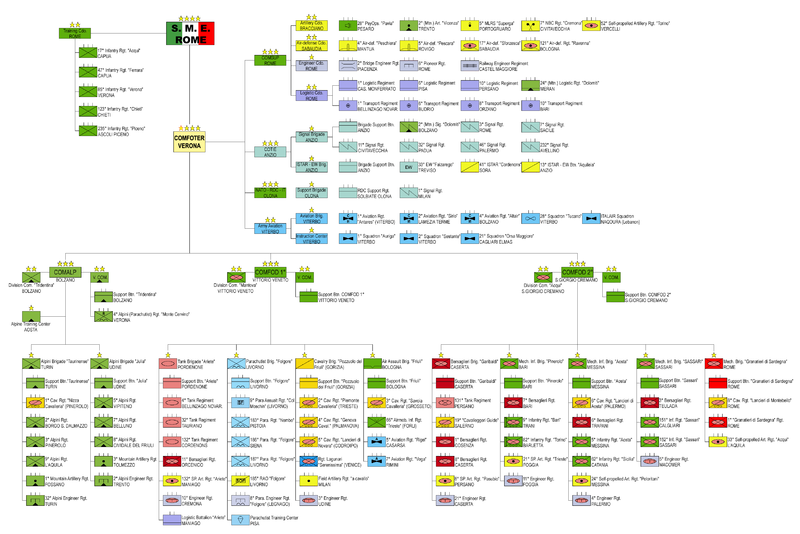 Full structure of the Italian Army (click to enlarge or see: Operational Structure of the Italian Army
Full structure of the Italian Army (click to enlarge or see: Operational Structure of the Italian Army
Effective operational capability
All brigades may be deployed outside Italy and are often involved in peace-keeping operations on foreign soil. The brigades are combat brigades, numbering between 3–7,000 troops each. These units are the pride of the Italian Army and are a front-line well-equipped force capable of dealing with most emergency situations. They are characterised by quality, efficiency, motivation and mobility.
Units designated as regiments are large battalions which consist of a large Command, Logistics, and Support Company plus a combat battalion, which, in the case of the infantry (Alpini, Bersaglieri, Granatieri, Lagunari, Infantry) units, consists of:
- 3 or 4 Infantry Companies
- 1 Mortar/Weapons Company
- 1 Antitank Company
The naming has historical reasons. Most regiments are deployed singularly, especially the support brigades' regiments as adjuncts to combat units, formed for the task ahead.
Equipment
Weapons
- Beretta AR70/90 - 5.56 mm assault rifle (also in SC and SCP versions)
- Beretta ARX 160 - 5.56 mm assault rifle
- Heckler & Koch G36 - 5.56 mm assault rifle
- HK416 - 5.56 mm assault rifle
- M4 Carbine - 5.56 mm assault rifle
- Beretta 92FS Glock-19, Glock 17 - 9 x 19 mm pistol
- Beretta Model 12 - 9 mm Luger Parabellum Submachine gun
- Heckler & Koch MP5 - 9 mm Luger Parabellum Submachine gun
- Heckler & Koch MP7 - 4.6x30 Submachine gun
- FN P90 - 5.7x28mm Submachine gun
- Minimi - 5.56 mm light machine gun
- MG42/59 - MG3 - 7.62 mm machine gun
- M2 Browning - 12.7 mm machine gun
- Franchi SPAS-12 - Shotgun
- Franchi SPAS-15 - Shotgun
- Sako TGR-42 - .338 Lapua sniper rifle
- Accuracy International Arctic Warfare - 7.62 mm sniper rifle
- Accuracy International AWM - .338 Lapua sniper rifle
- Barrett M82A1 - .50 BMG sniper rifle
- OD-82 grenade
- M203 - 40mm grenade grenade launcher
- Breda Folgore - Recoilless Gun
- Panzerfaust 3 - Anti-tank rocket launcher
- TOW II - Anti-tank guided missile
- MILAN 2T - Anti-tank guided missile
- Spike MR/LR - Anti-tank guided missile
- FIM-92 Stinger - Man-portable air-defense systems
Combat vehicles
- Ariete - Main battle tank (200)
- B1 Centauro - Tank destroyer/Armour fire support vehicle (300 in service, 100 in reserve)
- Dardo - Infantry fighting vehicle (200)
- VBM Freccia - Infantry fighting vehicle (49 in delivery of 249 planned)
- M113/M113A1/M106 - Armoured personnel carrier (3,000+ purchased, few in service as TOW or mortar carrier)
- VCC-1/VCC-2 - Armoured personnel carrier (1,300 purchased, 700 in service)
- Bandvagn 206 - Armoured personnel carrier (189)
- Puma 6x6 - Wheeled armoured personnel carrier (360)
- Puma 4x4 - Wheeled armoured recon vehicle (180)
- Cougar H armored fighting vehicle (6)
- VM90/Armored VM90 - Infantry mobility vehicle (1,280)
- VTLM Lince - Infantry mobility vehicle (1,260)
- AR90 - Reconnaissance-patrol vehicle/Fast attack vehicle (2,700, 50 with 12.7mm machine gun or 40mm grenade launcher)
- VAB NBC - Armoured reconnaissance-patrol vehicle (15)
- AAV7-A1 - Amphibious assault vehicle (25)
- Arisgator - Amphibious assault vehicle (30+)
- Bergeleopard - Armoured recovery vehicle (136)
- Pionierleopard - Armoured engineer vehicle (40)
- Biber - Armoured vehicle-launched bridge (64)
- Buffalo - Mine protected vehicle (6)
- ACTL 4x4/6x6/8x8 - Tactical-logistic vehicle (3,000+, the 4x4 version is airmobile)
- ACM 80/90 - Tactical-logistic vehicle (3,000+)
Artillery
- M109L - Self-propelled howitzer (192)
- PzH 2000 - Self-propelled howitzer (70)
- SIDAM 25 - Self-propelled anti-aircraft weapon (275)
- FH-70 - Towed howitzer (162)
- MLRS - Multiple launch rocket system (22)
- 120mm F1 - Mortar (180)
- Hirtenberger M6-111 60mm - Mortar (300+)
- MIM-23 HAWK - Rocket surface to air (60)
- SPADA 2000 - Surface to air missile system (50)
- FSAF SAMP/T - Surface to air missile system (6)
- SM 66.40 CAD - Artillery truck
Aircraft inventory
Aircraft Origin Type Versions In service[7] Notes Agusta A129 Mangusta  Italy
Italyattack helicopter CBT 60 Agusta A109  Italy
Italyutility helicopter A109EOA 12 Bell 412  United States
United Statestransport helicopter AB 412 23 built by Agusta Boeing CH-47 Chinook  United States
United Statestransport helicopter CH-47C 24 to be replaced with CH-47F Boeing CH-47 Chinook  United States
United Statestransport helicopter CH-47F 16 ordered NHI NH90  European Union
European Uniontransport helicopter TTH 40 total order of 60; delivery 2008-2012 Dornier Do 228  Germany
Germanyutility transport Do 228-200 3 Piaggio P180 Avanti  Italy
Italyutility transport P.180 M 3 Operations
A post-World War II peace treaty signed by Italy prevented the country from deploying military forces in overseas operations as well as possessing fixed-wing vessel-based aircraft for twenty-five years following the end of the war.
This treaty expired in 1970, but it would not be until 1982 that Italy first deployed troops on foreign soil, with a peacekeeping contingent being dispatched to Beirut following a United Nations request for troops. Since the 1980s, Italian troops have participated with other Western countries in peacekeeping operations across the world, especially in Africa, Balkan Peninsula and the Middle East.
As of yet, the Italian Army has not engaged in major combat operations since World War II; though Italian Special Forces have taken part in anti-Taliban operations in Afghanistan as part of Task Force 'Nibbio'. Italy was not yet a member of the United Nations in 1950, when that organization went to war with North Korea.
Italy did take part in the 1990-91 Gulf War but solely through the deployment of eight Italian Air Force Panavia Tornado IDS bomber jets to Saudi Arabia; Italian Army troops were subsequently deployed to assist Kurdish refugees in northern Iraq following the conflict.
As part of Operation Enduring Freedom in response to the September 11, 2001 attacks, Italy contributed to the international operation in Afghanistan. Italian forces have contributed to ISAF, the NATO force in Afghanistan, and a Provincial reconstruction team and 5 Italian soldiers have died under ISAF. Italy has sent 411 troops, based on one infantry company from the 2nd Alpini Regiment tasked to protect the ISAF HQ, one engineer company, one NBC platoon, one logistic unit, as well as liaison and staff elements integrated into the operation chain of command. Italian forces also command a multinational engineer task force and have deployed a platoon of Italian military police. Three AB 212 helicopters also were deployed to Kabul.
The Italian Army did not take part in combat operations of the 2003 Second Gulf War, dispatching troops only after May 1, 2003 - when major combat operations were declared over by the U.S. President George W. Bush. Subsequently Italian troops arrived in the late summer of 2003, and began patrolling Nasiriyah and the surrounding area. On 26 May 2006, Italian foreign minister Massimo d'Alema announced that the Italian forces would be reduced to 1,600 by June. As of June 2006 32 Italian troops have been killed in Iraq - with the greatest single loss of life coming on November 12, 2003 - a suicide car bombing of the Italian Carabinieri Corps HQ left a dozen Carabinieri, five Army soldiers, two Italian civilians, and eight Iraqi civilians dead.
As of 2006, Italy ranks third in the world in number of military forces operating in peacekeeping and peace-enforcing scenarios Afghanistan, Kosovo, Bosnia and Herzegovina, and Lebanon following only the United States and United Kingdom.
A recent law promotes membership of the Italian Army guaranteeing volunteers post-Army careers in the Carabinieri, Italian State Police, Italian Finance Police, State Forestry Department, Fire Department and other state bodies.
See also
- List of active units of the Italian Army
- Regio Esercito (World War II)
- Template:Italian Divisions World War II
Notes
- ^ (Italian) Italian Ministry of Defence. "Nota aggiuntiva 2010 definitiva". http://www.difesa.it/NR/rdonlyres/E006A984-0E90-42F4-A2CA-BDCAACADDFCE/0/Nota_Aggiuntiva_2010_definitiva_Gaeta_09_04_2010.pdf. Retrieved 2010-04-14.
- ^ Keegan (2001), p.319
- ^ Bierman & Smith (2002), pp.13-14
- ^ Walker (2003) pp.9-29
- ^ The Birth of AFSOUTH, accessed November 2011
- ^ "Chapter 9". NATO the first five years 1949-1954. NATO. http://www.nato.int/archives/1st5years/chapters/9.htm. Retrieved 2008-11-03.
- ^ "World Military Aircraft Inventory", Aerospace Source Book 2007, Aviation Week & Space Technology, January 15, 2007.
References
- Bierman, John; Smith, Colin (2003) [2002]. War without hate : the desert campaign of 1940-1943 (New edition ed.). New York: Penguin Books. ISBN 978-0142003947.
- Keegan, John (2001). The first World War; An Illustrated History. London: Hutchinson. ISBN 0-09-179392-0.
- Walker, Ian W. (2003). Iron Hulls, Iron Hearts; Mussolini's Elite Armoured Divisions in North Africa. Ramsbury: The Crowood Press. ISBN 1-86126-646-4.
Further reading
- Air International, article on the Italian Army Light Aviation, April 1992
External links
 Esercito Italiano (Army)
Esercito Italiano (Army)  Marina Militare (Navy)
Marina Militare (Navy)  Aeronautica Militare (Air Force)
Aeronautica Militare (Air Force)  Carabinieri (Gendarmerie)
Carabinieri (Gendarmerie)Armies (land forces) in Europe Sovereign
states- Albania
- Andorra
- Armenia
- Austria
- Azerbaijan
- Belarus
- Belgium
- Bosnia and Herzegovina
- Bulgaria
- Croatia
- Cyprus
- Czech Republic
- Denmark
- Estonia
- Finland
- France
- Georgia
- Germany
- Greece
- Hungary
- Iceland
- Ireland
- Italy
- Kazakhstan
- Latvia
- Liechtenstein
- Lithuania
- Luxembourg
- Macedonia
- Malta
- Moldova
- Monaco
- Montenegro
- Netherlands
- Norway
- Poland
- Portugal
- Romania
- Russia
- San Marino
- Serbia
- Slovakia
- Slovenia
- Spain
- Sweden
- Switzerland
- Turkey
- Ukraine
- United Kingdom
- Vatican City
States with limited
recognition- Abkhazia
- Kosovo
- Nagorno-Karabakh Republic
- Northern Cyprus
- South Ossetia
- Transnistria
Categories:- Italian Army (pre-1946)
- Italian Army (post-1946)
- Army aviation
Wikimedia Foundation. 2010.

